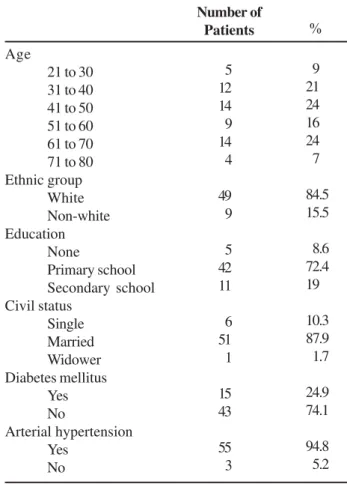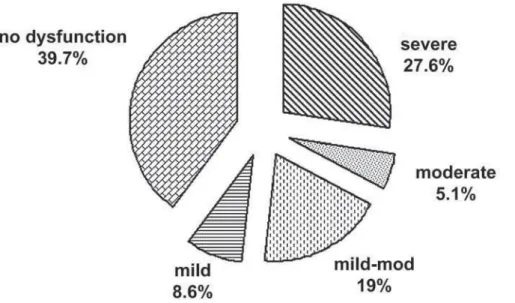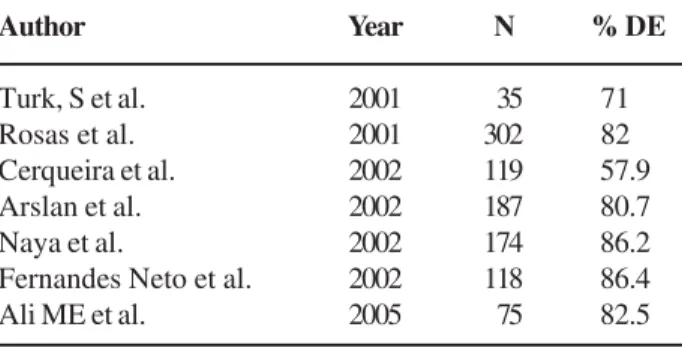Erectile Dysfunction in Patients with Chronic Renal Failure
Leonardo E. Messina, Joaquim A. Claro, Archimedes Nardozza, Enrico Andrade, Valdemar
Ortiz, Miguel Srougi
Section of Urology, Paulista School of Medicine, Federal University of Sao Paulo, UNIFESP,
Sao Paulo, SP, Brazil
ABSTRACT
Objective:Determine the prevalence of erectile dysfunction in patients undergoing hemodialysis.
Materials and Methods: This cross-sectional study was carried out to determine the prevalence of erectile dysfunction in a population of 58 patients in hemodialysis program. Erectile dysfunction was assessed by using the International Index of Erectile Function (IIEF). Information on demographic data, renal failure, comorbidities, laboratory tests and search for medical treatment for erectile dysfunction by means of interviews and researches in medical charts was obtained. Student t test was utilized to compare the laboratory results between group of patients with and without erectile dysfunction. The chi-square test was utilized to compare the comorbidities and the characteristics of the population studied between the groups of patients with and without erectile dysfunction. The significance level considered was 5%.
Results:Mean patient age was 50.2 ± 14.6 years and the time of hemodialysis was 30.4 ± 28.4 months. The prevalence of erectile dysfunction was 60.3%. A progressive increase respecting the age was reported. In patients younger than 50 years, this prevalence reached 31.4% and in patients older than 50 years, this prevalence reached 68.6%. With respect to the comorbidities, hypertensive patients prevailed with 94.8% of the total, whilst diabetic patients represented 24.9%. However only the association between diabetes and erectile dysfunction was significant. Patients with erectile dysfunction pre-sented significantly lower values for serum creatinine and Kt/V. There was no variation between the groups with reference to calcium, potassium, phosphorus, hematocrit, hemoglobin, pre- and post-dialysis urea values. There was no correlation between erectile dysfunction and time of dialysis. Amongst patients with erectile dysfunction, 8.6% sought medical care. Conclusions:The prevalence of erectile dysfunction in patients in hemodialysis program was of 60.3%. Age, diabetes and hemodialysis characteristics are associated to higher incidence of erectile dysfunction.
Key words: erectile dysfunction; chronic renal failure; hemodialysis; questionnaires
Int Braz J Urol. 2007; 33: 673-8
INTRODUCTION
Life expectancy of patients with chronic re-nal failure (CRF) increased during the last decades with the improvement of renal replacement techniques - dialysis and renal transplantation. However, new complications or aggravation of preexisting diseases
dysfunc-tion, by standardizing the questions and classifying the answers into categories. This study has been devel-oped to assess erectile dysfunction prevalence in pa-tients with Chronic Renal Failure utilizing the IIEF.
MATERIALS AND METHODS
Seventy patients older than 18 years have been selected in two hemodialysis centers and from these 58 patients (83%) agreed to participate in the research and signed the Informed Consent. The pa-tients answered the IIEF questionnaire including the six questions about health-related determinants of the erectile function (questions number 1 to 5 and ques-tion number 15). The total score ranges from 1 to 30, by being characterized as severe [1 to 6], moderate [7 to 12], mild to moderate [13 to 18], mild [19 to 24], and no dysfunction [25 to 30].
In the standard questionnaire applied sociodemographic data have been obtained (age, civil status and education level), presence of comorbidities (arterial hypertension and diabetes mellitus - DM) and time of hemodialysis.
Hematocrit, hemoglobin, calcium, phosphorus, potassium, pre- and post-dialysis urea and Kt/V val-ues have been all obtained from the medical charts, as well as the cause of the CRF.
Patients presenting ED were questioned if they have already searched for medical care for this problem.
Descriptive analysis of sociodemographic, clinic and laboratory data of the patients has been performed. The Student t test was utilized to compare laboratory results between patients with and without ED. The chi-square (χ2) test was utilized to compare the comorbidities and the characteristics of the population studied between the groups of patients with and with-out ED. The significance level considered was 5%.
RESULTS
The study included fifty-eight (58) patients with age ranging from 21 to 76 years (mean age of 50.2± 14.6 years). The proportion between patients
younger and older than 50 years was, respectively, 53.5% and 46.5%. Patients undergone hemodialysis for a minimum period of one week and a maximum period of 102 months (mean of 30.4 ± 28.4 months). Patients’ data can be found in Table-1.
The prevalence of ED was 60.3% (Figure-1). Progressive increase respecting the age was found. In patients younger than 50 years, the prevalence of ED was 31.4%, reaching 68.6% in those patients older than 50 years (p < 0.05).
No statistic association between sociodemo-graphic variables and ED has been found.
Hypertensive patients prevailed in the study (94.8%) with respect to the diabetic patients (24.9%). However only the association between DM and ED was significant (Table-2).
Time of dialysis was not a factor associated to the presence of ED in the population under study.
Table 1 – Characteristics of the population studied.
Age
Table 2 – Results found in patients with and without erectile dysfunction (ED).
Age
Up to 50 years of age Older than 51 years of age Diabetes mellitus
No Yes
Arterial hypertension No
Yes
Serum creatinine (mg/dL) +
Serum calcium (mg/dL) +
KT/V°
Serum potassium (mEq) +
Hematocrit (%)+
Hemoglobin (g/dL) +
Phosphorus (mg/dL) +
Pre urea (mg/dL) +
Post urea (mg/dL)°
Without ED
(N = 23)
With ED
(N = 35)
020 003
022 001
000 023 015.9± 4.5 012.4± 17.8 001.2± 0.4 004.8± 0.7 030.9± 7.3 009.8± 2.3 008.9± 9.7 155.1± 31.1 062.0± 24.5
011 024*
021 014*
003 032
011.6± 4.3*
008.7± 0.8
000.9± 0.2*
004.7± 0.7
028.5± 7.5
008.9± 2.4
006.3± 1.7 151.9± 38.8
072.3± 28.1
+ = data expressed as mean ± standard deviation, * = p < 0.05
Table 3 – International Index of Erectile Function (IIEF) in man with chronic renal failure.
Author
Turk, S et al. Rosas et al. Cerqueira et al. Arslan et al. Naya et al.
Fernandes Neto et al. Ali ME et al.
Year
2001 2001 2002 2002 2002 2002 2005
N
35 302 119 187 174 118 75
% DE
71 82 57.9 80.7 86.2 86.4 82.5 Amongst the laboratory tests, only creatinine and the Kt/V presented static statistic relation with the ED (Table-2).
Only three patients (8.6%) searched medical treatment for ED.
COMMENTS
In our sample, the prevalence of ED was 60.3%. Taking into consideration the only severe cat-egory, the prevalence was 27.6%. Initial studies re-ported that ED in patients undergoing hemodialysis ranged between 41% and 93% (1-3). Since the meth-odology of such studies was not uniform, the com-parison of the results found was not adequate. In stud-ies in which the International Index of Erectile Func-tion (IIEF) was utilized, the prevalence of ED ranged between 57.9% and 86.4% (4-12), evidencing that such dysfunction is frequent in patients with CRF (Table-3). Severe ED affects from 28% to 45% of these patients.
It is found in literature that ED is age-related (6-8,12,14). By stratifying the age of our patients be-low and above 50 yeas of age, we found, respectively, 31.4% and 68.6%, of ED prevalence.
The presence of hypertension found in our patients was 94.8%. However, this association was not significant. Several studies with chronic renal pa-tients found in literature do confirm this finding (1-8). Feldman et al. (15) pointed out the occurrence of se-vere ED in 15% of hypertensive patients treated against 9.6% in the general population. The study does
not indicate, however, if this association was origi-nated from the hypertension or from the use of anti-hypertensive medication by considering that there is also an association between ED and the use of hypotensives. It can be argued that the high degree of vascular impairment (atherosclerosis) present in men with CRF undergoing hemodialysis is at least partially responsible for the erectile mechanism aggravation (15).
With reference to the DM, there was a sig-nificant statistic association to the ED. This study in-dicated that only one amongst the fifteen patients did not have ED. In the patients evaluated by Cerqueira et al. (5), 99% of the diabetic patients presented ED. This association has been also found in other studies (4,8,10,15).
No statistic association of ED has been found with reference to civil status, education or ethnic groups. In the MMAS longitudinal study, Johannes et al. (14) reported that the risk of developing age-re-lated ED was higher in men with lower education degree. In our group, Moreira et al. (16) found that the education was inversely correlated to ED. Study carried out in four North-American cities, including 1,680 men older than 40 years of age, demonstrated that ED was not related to ethnic groups (17).
Time of dialysis was not also a factor associ-ated to the presence of ED in the population under study, similar result was found by other authors (6-8). Kt/V, measure of the quantity of plasma cleared of urea (K x t) divided by the volume of urea distribution (V) is an index utilized to assess dialysis adequacy. Patients with erectile dysfunction presented statistically significant lower values for Kt/V (0.9) when compared to patients without erectile dysfunc-tion (1.2). Some authors (18,19) recommend one Kt/ V of 1.3 for providing adequate hemodialysis. There-fore, the indexes found in our study can indicate that a hemodialysis within acceptable standards may con-tribute to prevent ED. This relation has not been found in other studies (1,4,7).
Amongst patients with ED, only three of them (8.6%) sought medical guidance. In the studies with chronic renal patients, the search for medical treat-ment ranged between 1% and 9.6% (7,8). It is found in literature that less than 10% of men seek medical care for ED (20). Moreira et al. (21) found that the number of individuals with ED that sought medical help was of 42%. The lack of approach regarding sexuality is caused, mostly, by health professionals that are not used to question the topic. The majority of the men doctors (62.5%) and women doctors (71.5%) reported that they do not routinely investigate the sexual function of the male patients. In a routine consulta-tion, only 11.1% and 8.7% of the men doctors and women doctors, respectively, reported they were used to always investigate the sexual function of male pa-tients. Amongst the patients, 78% of them did not re-fer about having problems to discuss sexual issues with their physicians (21).
CONCLUSIONS
The prevalence of ED in patients in hemodi-alysis program was 60.3%. However, only 8.6% of these patients search for medical help. Age, diabetes and hemodialysis characteristics are associated with higher incidence of ED. Physicians and other health professionals shall pay attention to the erection prob-lems in this group of patients in order to provide direc-tions for an adequate medical treatment.
CONFLICT OF INTEREST
None declared.
REFERENCES
1. Rodger RS, Fletcher K, Dewar JH, Genner D, McHugh M, Wilkinson R, et al.: Prevalence and pathogenesis of impotence in one hundred uremic men. Uremia Invest. 1984-1985; 8: 89-96.
2. Breza J, Reznicek J, Pribylincova V, Zvara P.: Erectile dysfunctions in patients treated with hemodialysis and kidney transplantation. Bratisl Lek Listy. 1993; 94: 489-93.
3. Palmer BF: Sexual dysfunction in uremia. J Am Soc Nephrol. 1999; 10: 1381-8.
4. Rosas SE, Joffe M, Franklin E, Strom BL, Kotzker W, Brensinger C, et al.: Prevalence and determinants of erectile dysfunction in hemodialysis patients. Kidney Int. 2001; 59: 2259-66.
5. Cerqueira J, Moraes M, Glina S.: Erectile dysfunction: prevalence and associated variables in patients with chronic renal failure. Int J Impot Res. 2002; 14: 65-71. 6. Naya Y, Soh J, Ochiai A, Mizutani Y, Ushijima S, Kamoi
K, et al.: Significant decrease of the International Index of Erectile Function in male renal failure patients treated with hemodialysis. Int J Impot Res. 2002; 14: 172-7. 7. Neto AF, de Freitas Rodrigues MA, Saraiva Fittipaldi
JA, Moreira ED Jr.: The epidemiology of erectile dys-function and its correlates in men with chronic renal failure on hemodialysis in Londrina, southern Brazil. Int J Impot Res. 2002; 14 Suppl 2: S19-26.
8. Arslan D, Aslan G, Sifil A, Cavdar C, Celebi I, Gamsari T, et al.: Sexual dysfunction in male patients on hemo-dialysis: assessment with the International Index of Erectile Function (IIEF). Int J Impot Res. 2002; 14: 539-42.
9. Krishnan R, Izatt S, Bargman JM, Oreopoulos D: Preva-lence and determinants of erectile dysfunction in pa-tients on peritoneal dialysis. Int Urol Nephrol. 2003; 35: 553-6.
10. Miyata Y, Shindo K, Matsuya F, Noguchi M, Nishikido M, Koga S, et al.: Erectile dysfunction in hemodialy-sis patients with diabetes mellitus: association with age and hemoglobin A1c levels. Int J Urol. 2004; 11: 530-4.
11. Turk S, Karalezli G, Tonbul HZ, Yildiz M, Altintepe L, Yildiz A, et al.: Erectile dysfunction and the effects of sildenafil treatment in patients on haemodialysis and continuous ambulatory peritoneal dialysis. Nephrol Dial Transplant. 2001; 16: 1818-22.
12. Ali ME, Abdel-Hafez HZ, Mahran AM, Mohamed HZ, Mohamed ER, El-Shazly AM, et al.: Erectile dysfunc-tion in chronic renal failure patients undergoing hemo-dialysis in Egypt. Int J Impot Res. 2005; 17: 180-5. 13. Rosen RC, Riley A, Wagner G, Osterloh IH, Kirkpatrick
J, Mishra A: The international index of erectile func-tion (IIEF): a multidimensional scale for assessment of erectile dysfunction. Urology. 1997; 49: 822-30. 14. Johannes CB, Araujo AB, Feldman HA, Derby CA,
15. Feldman HA, Goldstein I, Hatzichristou DG, Krane RJ, McKinlay JB: Impotence and its medical and psycho-social correlates: results of the Massachusetts Male Aging Study. J Urol. 1994; 151: 54-61.
16. Moreira ED Jr, Lisboa Lobo CF, Villa M, Nicolosi A, Glasser DB: Prevalence and correlates of erectile dys-function in Salvador, northeastern Brazil: a population-based study. Int J Impot Res. 2002; 14 Suppl 2: S3-9. 17. Jonler M, Moon T, Brannan W, Stone NN, Heisey D,
Bruskewitz RC: The effect of age, ethnicity and geo-graphical location on impotence and quality of life. Br J Urol. 1995; 75: 651-5.
18. Hauk M, Kuhlmann MK, Riegel W, Kohler H: In vivo effects of dialysate flow rate on Kt/V in maintenance
hemodialysis patients. Am J Kidney Dis. 2000; 35: 105-11.
19. Leon JB, Sehgal AR: Identifying patients at risk for he-modialysis underprescription. Am J Nephrol. 2001; 21: 200-7.
20. Driscoll CE, Garner EG, House JD. The effect of taking a sexual history on the notation of related diagnoses. Fam Med. 1986;18(5):293-5.
21. Moreira Jr ED, Abdo CHN, Santos DB, Wroclawski E, Fittipaldi JAS: Epidemiologia da disfunção erétil no Brasil: resultados da pesquisa nacional do “Projeto Avaliar”. Rev Bras Med. 2004; 61: 613-19.
Accepted after revision: May 20, 2007
Correspondence address:
Dr. Leonardo Eiras Messina Rua Arthur Gomes, 390, Centro Sorocaba, SP, Brazil
Fax: + 55 15 3233-2529


